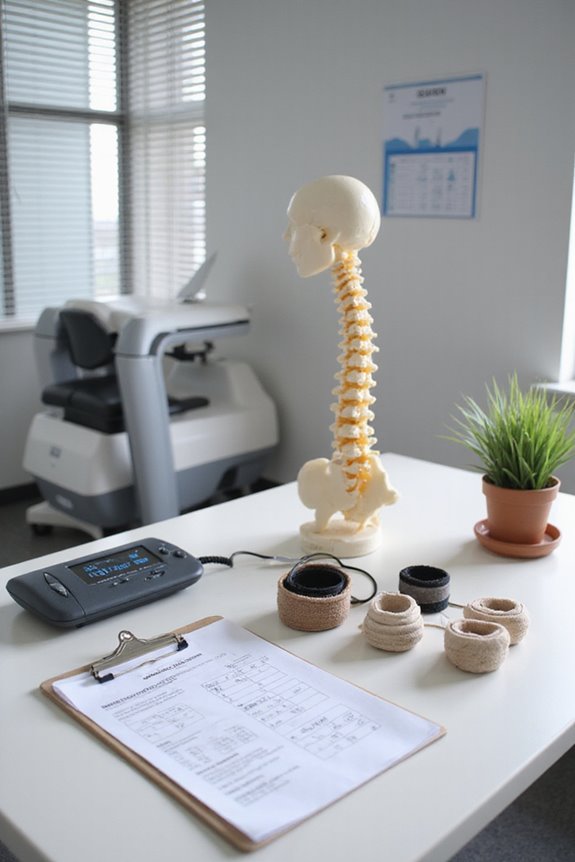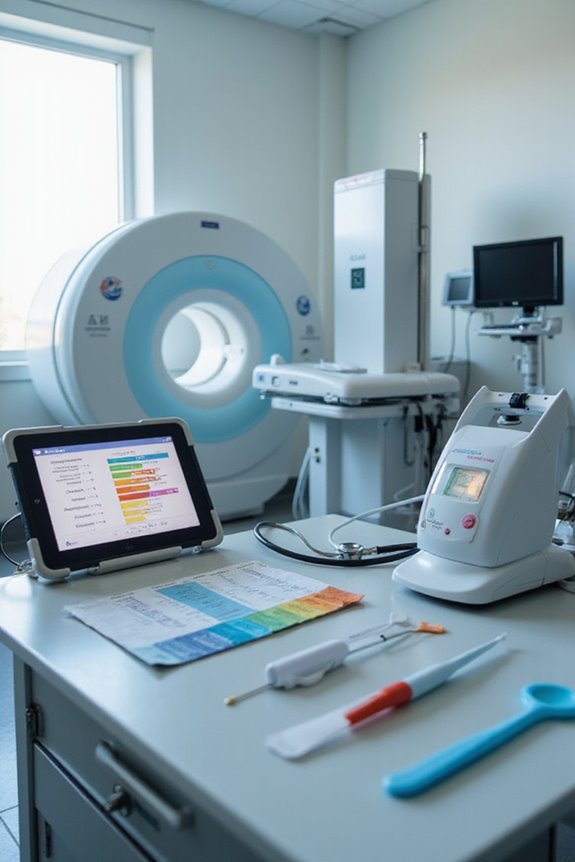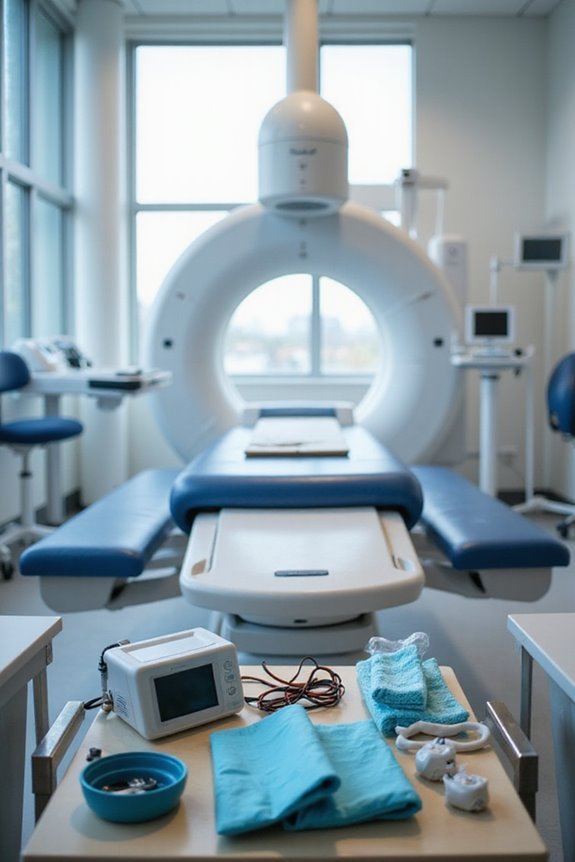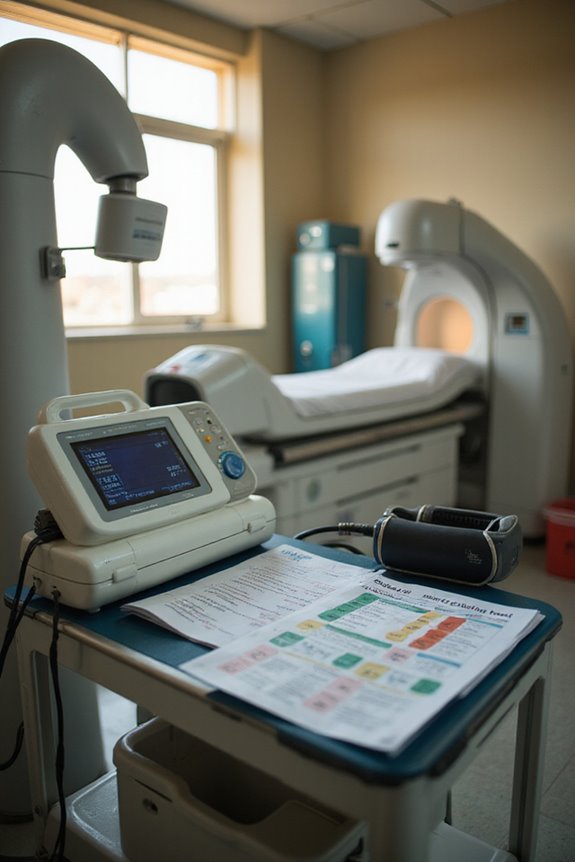Chronic pain greatly affects emergency diagnostic procedures. It leads to diagnostic ambiguity due to overlapping symptoms of acute and chronic conditions. Studies indicate that chronic pain accounts for up to 80% of emergency visits. Time constraints complicate evaluations, risking misdiagnosis. Proper assessment requires thorough patient histories and physical exams, while imaging can complicate interpretation. Understanding these challenges is essential. Further analysis reveals effective pain management strategies and safety considerations for best patient outcomes.
Key Takeaways
- Chronic pain can lead to diagnostic ambiguity, complicating the differentiation between exacerbations and new acute conditions in emergency settings.
- Time constraints in emergency departments may result in inadequate evaluations for chronic pain patients, impacting the accuracy of diagnoses.
- Complex patient histories associated with chronic pain complicate the diagnostic process, increasing the risk of misdiagnosis.
- Emergency staff biases toward chronic pain patients can negatively affect the thoroughness of diagnostic evaluations.
- Imaging techniques may complicate interpretation due to chronic changes, potentially leading to incorrect diagnoses in emergency situations.
Understanding Chronic Pain in Emergency Settings
Chronic pain presents a significant challenge in emergency settings, particularly when patients seek care for both ongoing discomfort and acute exacerbations. Chronic pain is a leading reason for emergency department visits, where patients may report baseline pain levels that are moderate to severe. This complicates the differentiation between new injuries or illnesses.
Key points in understanding chronic pain in emergency care include:
- Utilizing pain assessment tools such as the Numerical Rating Scale (NRS) and Visual Analog Scale (VAS).
- Recognizing that chronic pain patients often have comorbidities, which can complicate their presentations.
- The necessity for individualized pain management plans addressing both acute flare-ups and baseline pain control.
Effective emergency care requires a thorough understanding of these complexities.
Challenges in Accurate Diagnosis

Accurate diagnosis in emergency settings is often hindered by several key challenges.
- Diagnostic Ambiguity: Chronic pain symptoms frequently overlap with acute conditions, complicating differentiation. This overlap can lead to diagnostic errors, particularly when persistent pain masks signs of emergent pathology.
- Time Constraints: Emergency departments operate under significant time pressures. Quick diagnostic protocols may overlook the complexities of chronic pain, resulting in inadequate evaluations.
- Clinical Uncertainty: Emergency staff may experience frustration treating chronic pain patients, as ambiguity in presentations can undermine confidence in accurate diagnoses.
- Complex Patient Histories: Chronic pain patients often present with comorbid conditions, complicating the diagnostic process further.
- Limited Tools: Existing diagnostic protocols primarily address acute conditions, lacking guidelines for effectively evaluating chronic pain.
Impact on Diagnostic Procedures

The presence of chronic pain considerably influences diagnostic procedures within emergency settings. Chronic pain accounts for up to 80% of emergency department visits, necessitating accurate differentiation between exacerbations and new acute conditions to prevent misdiagnosis.
Key considerations include:
- Thorough patient history and physical examination are essential for evaluating chronic pain and identifying new symptoms.
- Emergency staff biases may impact the diagnostic thoroughness regarding chronic pain patients.
- Diagnostic testing is complex; imaging techniques like MRI are crucial yet can complicate interpretation due to chronic changes mimicking acute conditions.
- Maintaining routine protocols, such as full triage assessments, is critical for ensuring diagnostic accuracy in these situations.
Pain Management Strategies

Effective pain management strategies are essential in emergency settings, particularly for patients presenting with chronic pain.
Multimodal Analgesia
- Employ multiple analgesic agents to target various pain pathways, enhancing relief.
- Combine non-opioid medications, such as acetaminophen and NSAIDs, with adjuvants to minimize opioid use.
- Consider sub-dissociative dose ketamine for acute pain, noting potential side effects.
Patient Engagement
- Encourage active patient involvement in decision-making regarding pain management.
- Set realistic treatment goals focused on pain reduction and improved function.
- Integrate non-pharmacologic interventions such as physical modalities and cognitive-behavioral therapy for thorough care. Additionally, utilizing a TENS unit can provide effective pain relief during acute episodes.
Safety Considerations in Diagnostic Interventions

How can safety be guaranteed during diagnostic interventions for chronic pain patients? A thorough risk assessment is essential before any procedure. Key safety measures include:
- Medication Review: Evaluate all current medications, particularly blood thinners and opioids, to mitigate interaction risks.
- Allergy History: Assess for prior allergic reactions, especially to contrast agents.
- Comorbid Conditions: Thoroughly evaluate for infections or pregnancy, as these can affect safety.
- Anesthetic History: Review past anesthetic issues to prevent complications.
- Psychological Assessment: Address anxiety and depression to enhance cooperation and reduce stress during procedures.
These considerations ascertain that diagnostic interventions for chronic pain patients are conducted safely, minimizing potential risks and improving outcomes.
Frequently Asked Questions
How Can Patients Advocate for Themselves in the ED for Chronic Pain?
In the heat of the moment, patients can advocate for themselves in the ED by prioritizing clear patient communication and presenting a detailed pain management plan, ensuring their needs are understood and addressed promptly by medical staff.
What Role Does Mental Health Play in Chronic Pain Management in the ED?
Mental health greatly influences chronic pain management in the emergency department. It affects pain perception, complicating treatment strategies. Addressing mental health concerns through screening can enhance overall patient outcomes and foster a supportive environment for healing.
Are There Alternative Therapies for Chronic Pain Patients in Emergency Settings?
In emergency settings, alternative therapies like acupuncture benefits and mindfulness practices offer promising pain relief options for chronic pain patients, fostering a sense of community and belonging while reducing reliance on traditional pharmacological treatments.
How Can Family Members Support Chronic Pain Patients During ED Visits?
Like a lighthouse guiding a ship through turbulent waters, family members can offer emotional support and effective communication strategies, fostering understanding and collaboration during emergency visits, ultimately enhancing the chronic pain patient’s experience and outcomes.
What Resources Are Available for Chronic Pain EDucation in the ED?
Numerous chronic pain resources and education initiatives exist to support emergency departments. Institutions like the ACPA, PainEDU, and NIH promote extensive training, enhancing clinician knowledge and improving patient care in managing chronic pain effectively.





